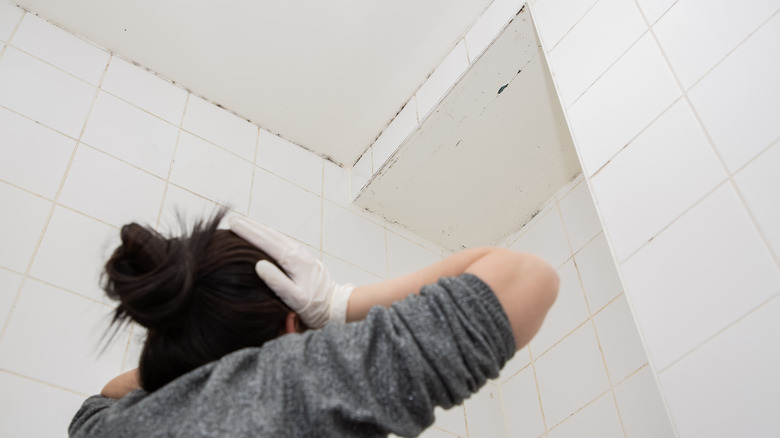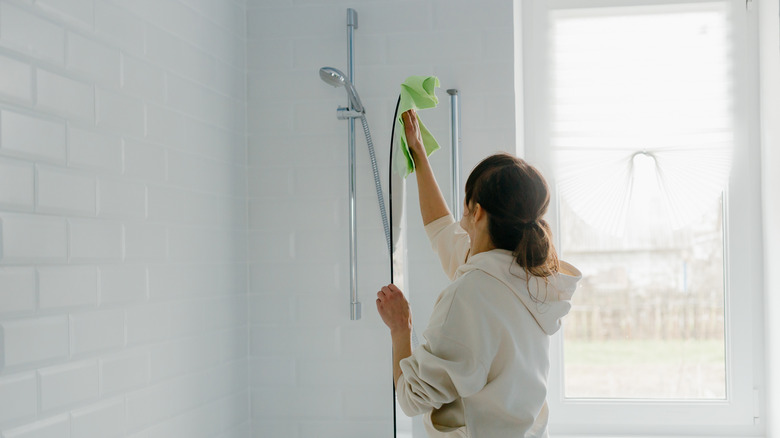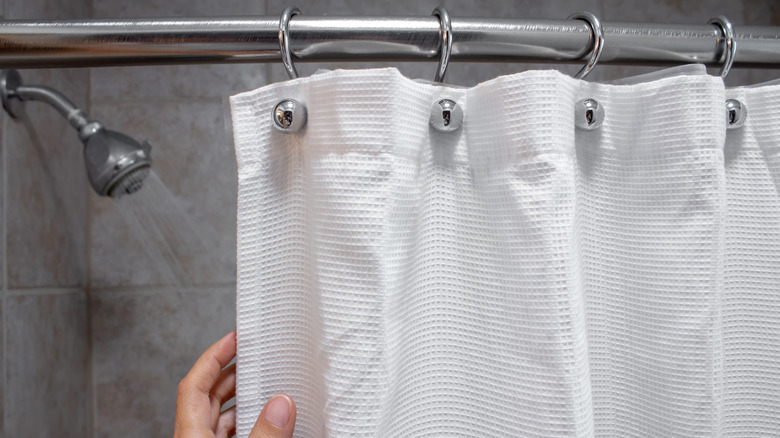How To Stop Mold From Returning In Your Shower, According To An Expert
After a long hard day, it's so satisfying to soak in a nice relaxing bath or to wash the day's stress and grime away with a hot steamy shower. However, nothing puts a damper on these euphoric cleansing rituals more than the presence of disgusting mold. Those black, green, purple, or brown slimy spots that appear in the corners and ceiling of your shower mean that mold is setting in. The signs of mold are not only unsettling — especially in an area that is associated with cleaning your body — but they can also be harmful to your health. Black mold, in particular, can cause respiratory problems for those that suffer from asthma or allergies.
So if you're looking to prevent this fungus from ever forming, it helps to take advice from an expert. In an exclusive interview with House Digest, we asked the Operations Manager at the Ministry Of Cleaning, Prerna Jain, how to stop mold from forming or returning to your shower. "First thing first, let's first understand why mold grows anywhere, including in showers," Jain tells us, "Mold thrives in moist and dark environments, where there is a lack of proper ventilation and/or maintenance." This could make your bathroom the ideal breeding ground for future fungi. "When it comes to any wet areas like showers, the first condition is met," Jain says, "Add a faulty exhaust fan or closed windows and doors, and you have a recipe for mold."
Keep the area clean and dry
Your bathroom has all the elements to make it the perfect place for mold and mildew to grow, so you need to do everything you can to deter the growth before it starts. "Make sure to clean the shower and surrounding area regularly," expert Prerna Jain tells us, "This includes scrubbing the walls and floors and wiping down the fixtures. Additionally, clean the shower curtains and doors, as mold can accumulate on these surfaces." For a simple cleaning solution that's sure to bust bacteria, a combination of diluted vinegar, water, and lemon in a spray bottle and then spritzed on a bit of baking soda is just the thing to keep your area clean.
"Keep the moisture levels down," Jain also recommends, "Check your bathroom for any leaks, as this can be a source of moisture and mold growth." A collection of stagnant water is a surefire way for fungi to start forming, so it's helpful to inspect the drains and pipes for any weak spots. "Make sure any leaks are repaired immediately to prevent water from seeping into the walls and floors. Also, install a portable dehumidifier if needed." She also stresses the importance of airflow in this moist environment. "Make sure your bathroom is properly ventilated to help reduce moisture and prevent mold growth," she says, "Open windows when possible and use an exhaust fan to help remove moisture from the air. Replace any faulty exhaust fans."
Use mold-resistant products
Mold spreads and grows in moist environments but also on materials that are able to retain this type of dampness. When wet, wood, drywall, insulation, fabrics, and ceiling tiles are just the type of products that provide the perfect conditions to help fungi flourish. That's why if you want to prevent mold and mildew from forming in the first place, it would be beneficial to utilize the types of textiles that can prevent future growth. "Invest in a shower curtain made of a material that is resistant to mold and mildew, such as vinyl, plastic, or nylon," expert Prerna Jain suggests, "Additionally, make sure to wash and dry the shower curtain regularly." If you spot mold on your shower curtain, make certain to treat it with a cleaning solution right away to stop the spread. If the problem is too severe, then it would be wise to toss out the curtain and buy a new one.
Before you decide on a new paint color for your bathroom, consider what paint you use. "When painting your bathroom, make sure to use a paint that is resistant to mold and mildew," Jain advises, "Additionally, make sure to apply two coats of paint and to let it dry completely between coats. This will help to create a moisture-resistant barrier that can help to prevent mold growth."


